Business Decision Analysis: NPV, Payback & Financial/Non-Financial
VerifiedAdded on 2023/06/11
|7
|1370
|466
Essay
AI Summary
This essay delves into the critical aspects of business decision-making, emphasizing the importance of a structured approach to determine objectives, assess essential details, and evaluate alternatives. It focuses on computing the Net Present Value (NPV) and payback period for two projects, Vegan Chocolates and Vegan Spread, providing a detailed financial analysis. The essay interprets the calculated payback periods and NPVs to guide investment decisions, highlighting that Project B (Vegan Spread) has a shorter payback period while Project A (Vegan Chocolates) has a higher NPV. Furthermore, it explores the significance of both financial and non-financial factors in decision-making, such as maintaining company position, motivating employees, improving communication with distributors and customers, enhancing organizational goodwill, and planning for future risks. The report concludes that effective business decision-making is essential for systematic and effective operations, enabling companies to analyze their exact position and make informed choices.

Essay on Business
Decision Making
Decision Making
Paraphrase This Document
Need a fresh take? Get an instant paraphrase of this document with our AI Paraphraser
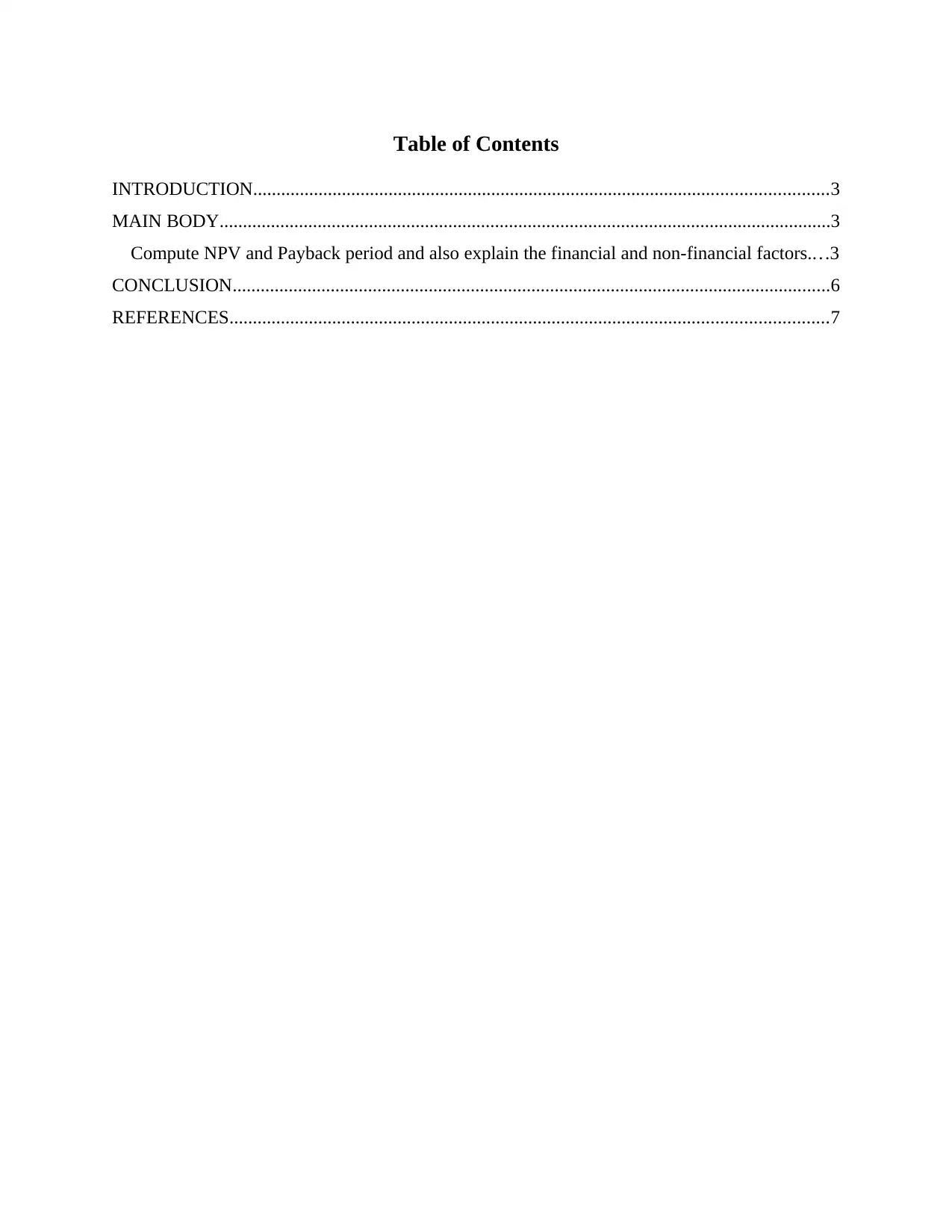
Table of Contents
INTRODUCTION...........................................................................................................................3
MAIN BODY...................................................................................................................................3
Compute NPV and Payback period and also explain the financial and non-financial factors....3
CONCLUSION................................................................................................................................6
REFERENCES................................................................................................................................7
INTRODUCTION...........................................................................................................................3
MAIN BODY...................................................................................................................................3
Compute NPV and Payback period and also explain the financial and non-financial factors....3
CONCLUSION................................................................................................................................6
REFERENCES................................................................................................................................7
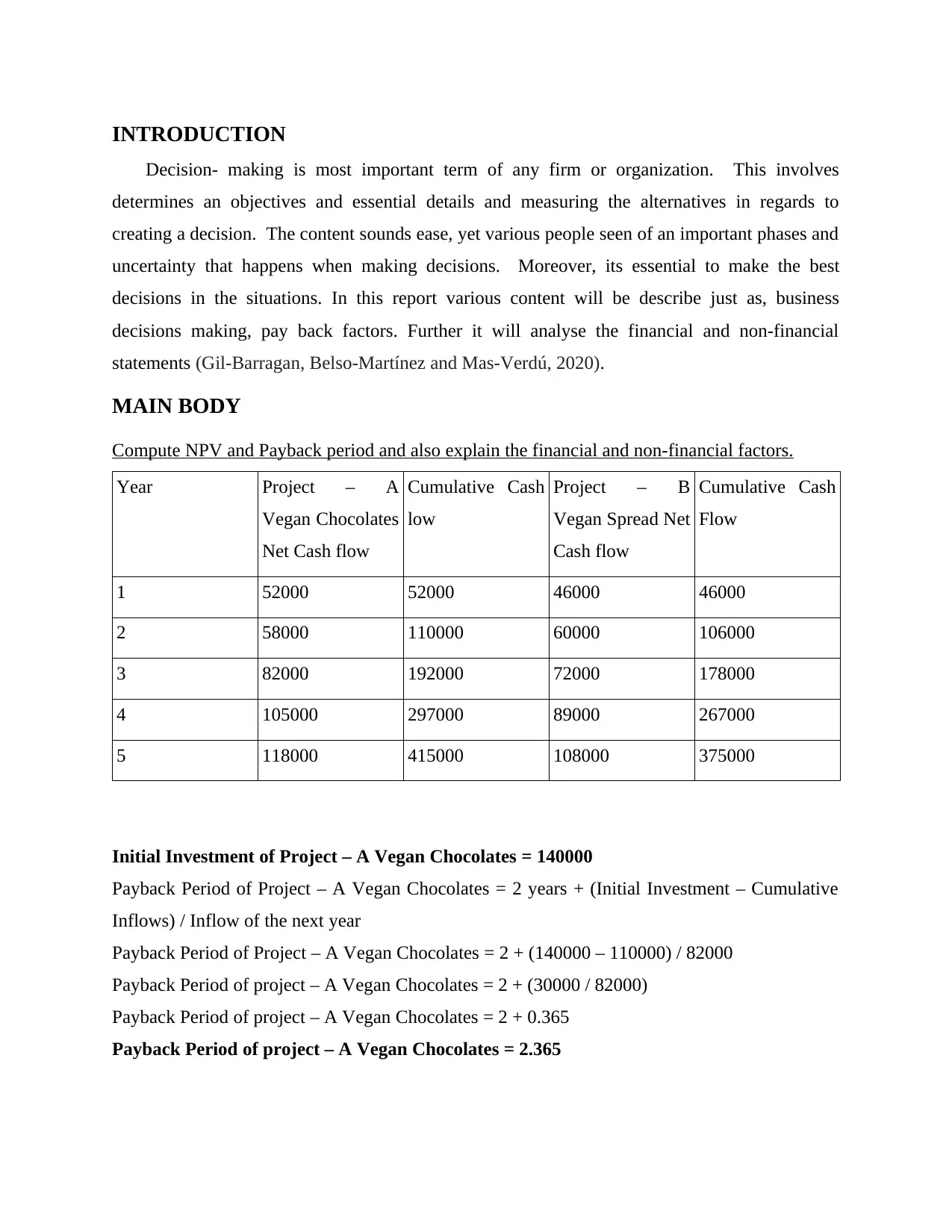
INTRODUCTION
Decision- making is most important term of any firm or organization. This involves
determines an objectives and essential details and measuring the alternatives in regards to
creating a decision. The content sounds ease, yet various people seen of an important phases and
uncertainty that happens when making decisions. Moreover, its essential to make the best
decisions in the situations. In this report various content will be describe just as, business
decisions making, pay back factors. Further it will analyse the financial and non-financial
statements (Gil-Barragan, Belso-Martínez and Mas-Verdú, 2020).
MAIN BODY
Compute NPV and Payback period and also explain the financial and non-financial factors.
Year Project – A
Vegan Chocolates
Net Cash flow
Cumulative Cash
low
Project – B
Vegan Spread Net
Cash flow
Cumulative Cash
Flow
1 52000 52000 46000 46000
2 58000 110000 60000 106000
3 82000 192000 72000 178000
4 105000 297000 89000 267000
5 118000 415000 108000 375000
Initial Investment of Project – A Vegan Chocolates = 140000
Payback Period of Project – A Vegan Chocolates = 2 years + (Initial Investment – Cumulative
Inflows) / Inflow of the next year
Payback Period of Project – A Vegan Chocolates = 2 + (140000 – 110000) / 82000
Payback Period of project – A Vegan Chocolates = 2 + (30000 / 82000)
Payback Period of project – A Vegan Chocolates = 2 + 0.365
Payback Period of project – A Vegan Chocolates = 2.365
Decision- making is most important term of any firm or organization. This involves
determines an objectives and essential details and measuring the alternatives in regards to
creating a decision. The content sounds ease, yet various people seen of an important phases and
uncertainty that happens when making decisions. Moreover, its essential to make the best
decisions in the situations. In this report various content will be describe just as, business
decisions making, pay back factors. Further it will analyse the financial and non-financial
statements (Gil-Barragan, Belso-Martínez and Mas-Verdú, 2020).
MAIN BODY
Compute NPV and Payback period and also explain the financial and non-financial factors.
Year Project – A
Vegan Chocolates
Net Cash flow
Cumulative Cash
low
Project – B
Vegan Spread Net
Cash flow
Cumulative Cash
Flow
1 52000 52000 46000 46000
2 58000 110000 60000 106000
3 82000 192000 72000 178000
4 105000 297000 89000 267000
5 118000 415000 108000 375000
Initial Investment of Project – A Vegan Chocolates = 140000
Payback Period of Project – A Vegan Chocolates = 2 years + (Initial Investment – Cumulative
Inflows) / Inflow of the next year
Payback Period of Project – A Vegan Chocolates = 2 + (140000 – 110000) / 82000
Payback Period of project – A Vegan Chocolates = 2 + (30000 / 82000)
Payback Period of project – A Vegan Chocolates = 2 + 0.365
Payback Period of project – A Vegan Chocolates = 2.365
⊘ This is a preview!⊘
Do you want full access?
Subscribe today to unlock all pages.

Trusted by 1+ million students worldwide
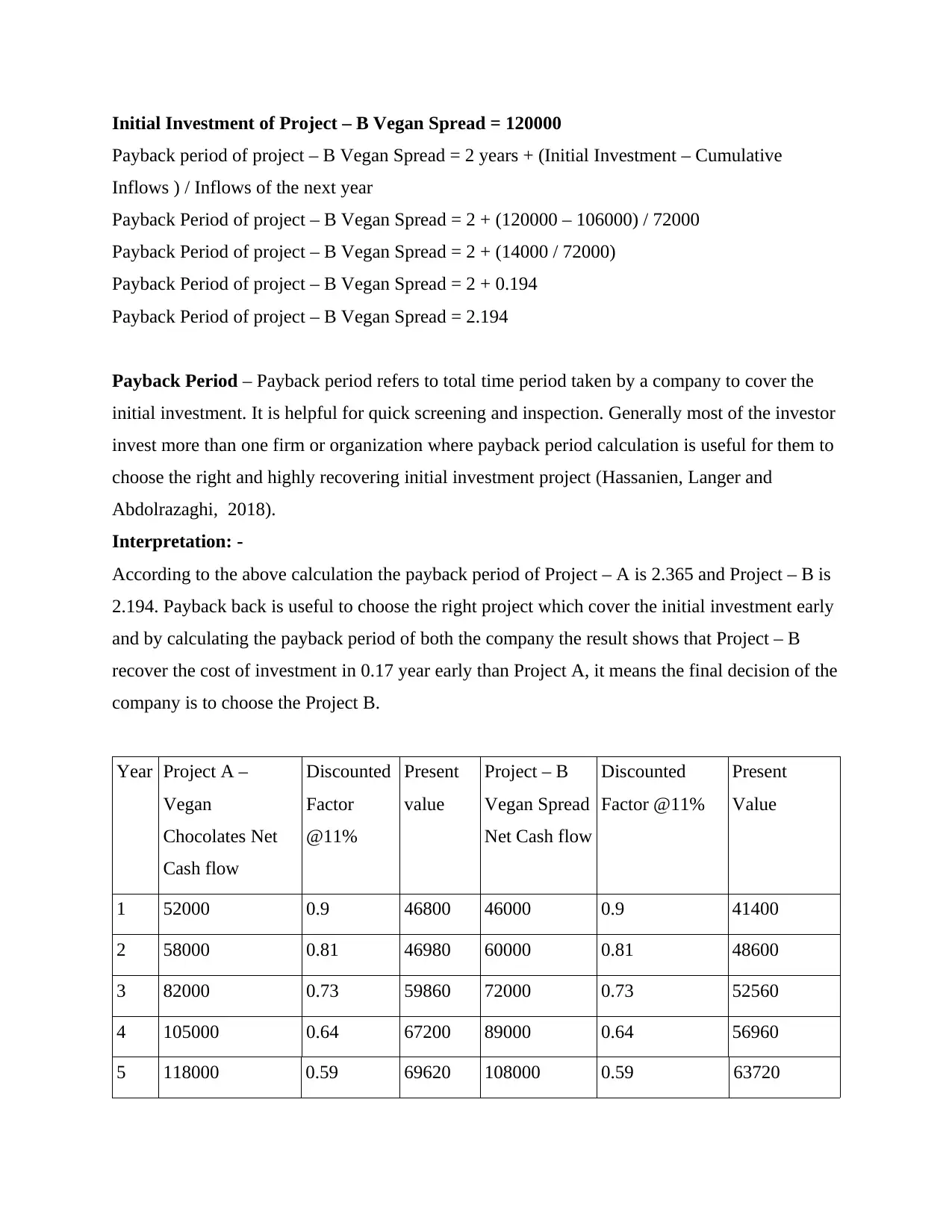
Initial Investment of Project – B Vegan Spread = 120000
Payback period of project – B Vegan Spread = 2 years + (Initial Investment – Cumulative
Inflows ) / Inflows of the next year
Payback Period of project – B Vegan Spread = 2 + (120000 – 106000) / 72000
Payback Period of project – B Vegan Spread = 2 + (14000 / 72000)
Payback Period of project – B Vegan Spread = 2 + 0.194
Payback Period of project – B Vegan Spread = 2.194
Payback Period – Payback period refers to total time period taken by a company to cover the
initial investment. It is helpful for quick screening and inspection. Generally most of the investor
invest more than one firm or organization where payback period calculation is useful for them to
choose the right and highly recovering initial investment project (Hassanien, Langer and
Abdolrazaghi, 2018).
Interpretation: -
According to the above calculation the payback period of Project – A is 2.365 and Project – B is
2.194. Payback back is useful to choose the right project which cover the initial investment early
and by calculating the payback period of both the company the result shows that Project – B
recover the cost of investment in 0.17 year early than Project A, it means the final decision of the
company is to choose the Project B.
Year Project A –
Vegan
Chocolates Net
Cash flow
Discounted
Factor
@11%
Present
value
Project – B
Vegan Spread
Net Cash flow
Discounted
Factor @11%
Present
Value
1 52000 0.9 46800 46000 0.9 41400
2 58000 0.81 46980 60000 0.81 48600
3 82000 0.73 59860 72000 0.73 52560
4 105000 0.64 67200 89000 0.64 56960
5 118000 0.59 69620 108000 0.59 63720
Payback period of project – B Vegan Spread = 2 years + (Initial Investment – Cumulative
Inflows ) / Inflows of the next year
Payback Period of project – B Vegan Spread = 2 + (120000 – 106000) / 72000
Payback Period of project – B Vegan Spread = 2 + (14000 / 72000)
Payback Period of project – B Vegan Spread = 2 + 0.194
Payback Period of project – B Vegan Spread = 2.194
Payback Period – Payback period refers to total time period taken by a company to cover the
initial investment. It is helpful for quick screening and inspection. Generally most of the investor
invest more than one firm or organization where payback period calculation is useful for them to
choose the right and highly recovering initial investment project (Hassanien, Langer and
Abdolrazaghi, 2018).
Interpretation: -
According to the above calculation the payback period of Project – A is 2.365 and Project – B is
2.194. Payback back is useful to choose the right project which cover the initial investment early
and by calculating the payback period of both the company the result shows that Project – B
recover the cost of investment in 0.17 year early than Project A, it means the final decision of the
company is to choose the Project B.
Year Project A –
Vegan
Chocolates Net
Cash flow
Discounted
Factor
@11%
Present
value
Project – B
Vegan Spread
Net Cash flow
Discounted
Factor @11%
Present
Value
1 52000 0.9 46800 46000 0.9 41400
2 58000 0.81 46980 60000 0.81 48600
3 82000 0.73 59860 72000 0.73 52560
4 105000 0.64 67200 89000 0.64 56960
5 118000 0.59 69620 108000 0.59 63720
Paraphrase This Document
Need a fresh take? Get an instant paraphrase of this document with our AI Paraphraser
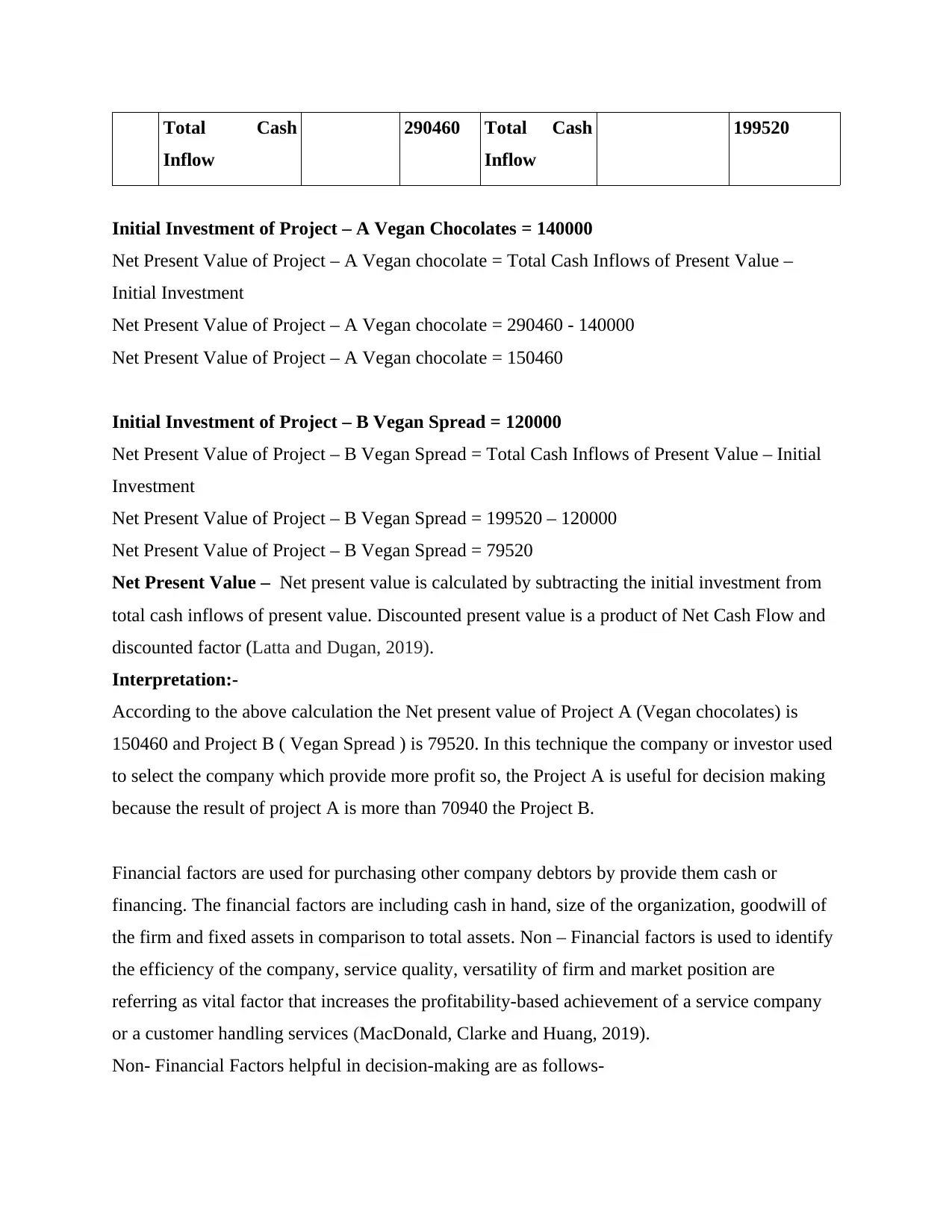
Total Cash
Inflow
290460 Total Cash
Inflow
199520
Initial Investment of Project – A Vegan Chocolates = 140000
Net Present Value of Project – A Vegan chocolate = Total Cash Inflows of Present Value –
Initial Investment
Net Present Value of Project – A Vegan chocolate = 290460 - 140000
Net Present Value of Project – A Vegan chocolate = 150460
Initial Investment of Project – B Vegan Spread = 120000
Net Present Value of Project – B Vegan Spread = Total Cash Inflows of Present Value – Initial
Investment
Net Present Value of Project – B Vegan Spread = 199520 – 120000
Net Present Value of Project – B Vegan Spread = 79520
Net Present Value – Net present value is calculated by subtracting the initial investment from
total cash inflows of present value. Discounted present value is a product of Net Cash Flow and
discounted factor (Latta and Dugan, 2019).
Interpretation:-
According to the above calculation the Net present value of Project A (Vegan chocolates) is
150460 and Project B ( Vegan Spread ) is 79520. In this technique the company or investor used
to select the company which provide more profit so, the Project A is useful for decision making
because the result of project A is more than 70940 the Project B.
Financial factors are used for purchasing other company debtors by provide them cash or
financing. The financial factors are including cash in hand, size of the organization, goodwill of
the firm and fixed assets in comparison to total assets. Non – Financial factors is used to identify
the efficiency of the company, service quality, versatility of firm and market position are
referring as vital factor that increases the profitability-based achievement of a service company
or a customer handling services (MacDonald, Clarke and Huang, 2019).
Non- Financial Factors helpful in decision-making are as follows-
Inflow
290460 Total Cash
Inflow
199520
Initial Investment of Project – A Vegan Chocolates = 140000
Net Present Value of Project – A Vegan chocolate = Total Cash Inflows of Present Value –
Initial Investment
Net Present Value of Project – A Vegan chocolate = 290460 - 140000
Net Present Value of Project – A Vegan chocolate = 150460
Initial Investment of Project – B Vegan Spread = 120000
Net Present Value of Project – B Vegan Spread = Total Cash Inflows of Present Value – Initial
Investment
Net Present Value of Project – B Vegan Spread = 199520 – 120000
Net Present Value of Project – B Vegan Spread = 79520
Net Present Value – Net present value is calculated by subtracting the initial investment from
total cash inflows of present value. Discounted present value is a product of Net Cash Flow and
discounted factor (Latta and Dugan, 2019).
Interpretation:-
According to the above calculation the Net present value of Project A (Vegan chocolates) is
150460 and Project B ( Vegan Spread ) is 79520. In this technique the company or investor used
to select the company which provide more profit so, the Project A is useful for decision making
because the result of project A is more than 70940 the Project B.
Financial factors are used for purchasing other company debtors by provide them cash or
financing. The financial factors are including cash in hand, size of the organization, goodwill of
the firm and fixed assets in comparison to total assets. Non – Financial factors is used to identify
the efficiency of the company, service quality, versatility of firm and market position are
referring as vital factor that increases the profitability-based achievement of a service company
or a customer handling services (MacDonald, Clarke and Huang, 2019).
Non- Financial Factors helpful in decision-making are as follows-

To maintain the company position good decision making is important. This factor helpful
in providing ideas or ethics and set of rules and regulation for future decision- making.
It is usually help to motivate the employees for better efficiency and also important to
hire and keep employees. Manager play a role of motivator and gives incentives and
bonus to their employees who are giving the effective result.
It improves the communication level and healthy relation between the distributor and
customers. Supplier are useful for selling the goods or service to their customer by
maintaining the good relationship with the client. More supply tends to be more profit in
business and it is directly depending on the customer.
This factor tries to increase the goodwill of the organization by improving skills
regularly, developing new techniques, capture most of the areas for increasing the
business and increasing the company management.
It also tries to planned for future risk and threats, such as protecting the intellectual
building against the potential competitor (Schätter and et.al., 2019).
CONCLUSION
From the above report it is concluded that business decision making is essential so that work
can be done systematically and effectively although it is an activity that helps the company to
analyse the exact position of the company. It also concluded in above the concept of business
decisions making and financial statements according to the values.
in providing ideas or ethics and set of rules and regulation for future decision- making.
It is usually help to motivate the employees for better efficiency and also important to
hire and keep employees. Manager play a role of motivator and gives incentives and
bonus to their employees who are giving the effective result.
It improves the communication level and healthy relation between the distributor and
customers. Supplier are useful for selling the goods or service to their customer by
maintaining the good relationship with the client. More supply tends to be more profit in
business and it is directly depending on the customer.
This factor tries to increase the goodwill of the organization by improving skills
regularly, developing new techniques, capture most of the areas for increasing the
business and increasing the company management.
It also tries to planned for future risk and threats, such as protecting the intellectual
building against the potential competitor (Schätter and et.al., 2019).
CONCLUSION
From the above report it is concluded that business decision making is essential so that work
can be done systematically and effectively although it is an activity that helps the company to
analyse the exact position of the company. It also concluded in above the concept of business
decisions making and financial statements according to the values.
⊘ This is a preview!⊘
Do you want full access?
Subscribe today to unlock all pages.

Trusted by 1+ million students worldwide
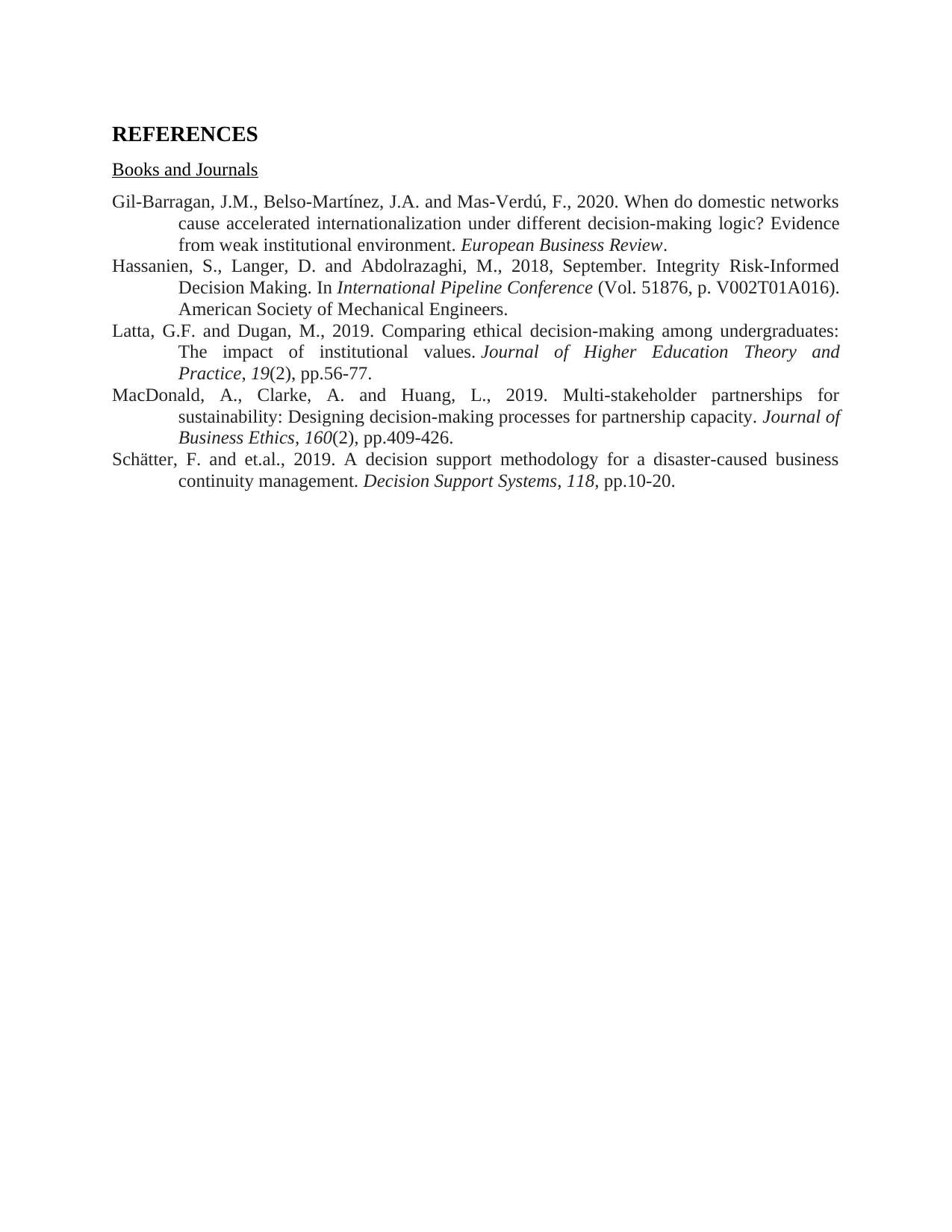
REFERENCES
Books and Journals
Gil-Barragan, J.M., Belso-Martínez, J.A. and Mas-Verdú, F., 2020. When do domestic networks
cause accelerated internationalization under different decision-making logic? Evidence
from weak institutional environment. European Business Review.
Hassanien, S., Langer, D. and Abdolrazaghi, M., 2018, September. Integrity Risk-Informed
Decision Making. In International Pipeline Conference (Vol. 51876, p. V002T01A016).
American Society of Mechanical Engineers.
Latta, G.F. and Dugan, M., 2019. Comparing ethical decision-making among undergraduates:
The impact of institutional values. Journal of Higher Education Theory and
Practice, 19(2), pp.56-77.
MacDonald, A., Clarke, A. and Huang, L., 2019. Multi-stakeholder partnerships for
sustainability: Designing decision-making processes for partnership capacity. Journal of
Business Ethics, 160(2), pp.409-426.
Schätter, F. and et.al., 2019. A decision support methodology for a disaster-caused business
continuity management. Decision Support Systems, 118, pp.10-20.
Books and Journals
Gil-Barragan, J.M., Belso-Martínez, J.A. and Mas-Verdú, F., 2020. When do domestic networks
cause accelerated internationalization under different decision-making logic? Evidence
from weak institutional environment. European Business Review.
Hassanien, S., Langer, D. and Abdolrazaghi, M., 2018, September. Integrity Risk-Informed
Decision Making. In International Pipeline Conference (Vol. 51876, p. V002T01A016).
American Society of Mechanical Engineers.
Latta, G.F. and Dugan, M., 2019. Comparing ethical decision-making among undergraduates:
The impact of institutional values. Journal of Higher Education Theory and
Practice, 19(2), pp.56-77.
MacDonald, A., Clarke, A. and Huang, L., 2019. Multi-stakeholder partnerships for
sustainability: Designing decision-making processes for partnership capacity. Journal of
Business Ethics, 160(2), pp.409-426.
Schätter, F. and et.al., 2019. A decision support methodology for a disaster-caused business
continuity management. Decision Support Systems, 118, pp.10-20.
1 out of 7
Related Documents
Your All-in-One AI-Powered Toolkit for Academic Success.
+13062052269
info@desklib.com
Available 24*7 on WhatsApp / Email
![[object Object]](/_next/static/media/star-bottom.7253800d.svg)
Unlock your academic potential
Copyright © 2020–2025 A2Z Services. All Rights Reserved. Developed and managed by ZUCOL.

